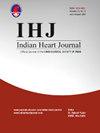Outcomes of post myocardial infarction ventricular septal rupture: Experience from an Indian tertiary cardiac center
IF 1.8
Q3 CARDIAC & CARDIOVASCULAR SYSTEMS
引用次数: 0
Abstract
Background
Post myocardial infarction ventricular septal rupture (MI-VSR) is a devastating complication after acute myocardial infarction (AMI); lacks uniform treatment recommendations and carries poor outcomes.
Objectives
To evaluate the outcomes of post MI-VSR, stratify based on management strategy and determine the predictors of survival.
Methods
All cases of VSR hospitalized in a tertiary referral cardiac care center over 11 years were retrospectively evaluated for various parameters and stratified based on the modality of treatment, either conservative, surgical or transcatheter closure.
Results
Among a total of 131 cases of VSR with a median age of 65 years, hospitalized from January 2013 to December 2023, 47(35.9 %) had surgical closure, 25(19.1 %) had transcatheter closure and the rest were managed conservatively. 11(8.4 %) cases alone underwent primary percutaneous coronary intervention (PCI). Apex was the commonest (79.3 %) site. Older patients and patients in higher stages of shock at the time of VSR diagnosis were often managed conservatively. Two-thirds of surgical patients were in SHOCK stage A or B; three-fourths of transcatheter group were in stage C or D. Overall mortality was 71 % with 100 % in conservative, 68 % in transcatheter closure and 36.2 % in surgical group. Younger age, lower shock stage, VSR closure, and delayed closure were predictors of survival.
Conclusions
Post MI VSR outcomes were poor, based on the hemodynamic status. Closure of VSR is essential for survival. Surgical closure had lower mortality than transcatheter closure possibly contributed by a selection bias.
心肌梗死后室间隔破裂的结果:来自印度三级心脏中心的经验。
背景:心肌梗死后室间隔破裂(MI-VSR)是急性心肌梗死(AMI)后的一种破坏性并发症;缺乏统一的治疗建议,结果不佳。目的:评估MI-VSR后的预后,根据管理策略进行分层,确定生存预测因素。方法:回顾性评估所有在三级转诊心脏护理中心住院11年以上的VSR病例的各种参数,并根据治疗方式(保守、手术或经导管闭合)进行分层。结果:2013年1月至2023年12月住院的131例VSR患者中位年龄为65岁,其中47例(35.9%)行手术封闭,25例(19.1%)行经导管封闭,其余行保守治疗。11例(8.4%)单独接受了经皮冠状动脉介入治疗(PCI)。顶端是最常见的部位(79.3%)。老年患者和在VSR诊断时处于较高休克阶段的患者通常采用保守治疗。三分之二的手术患者处于休克A期或B期;经导管组四分之三的患者处于C期或d期。总的死亡率为71%,保守组为100%,经导管关闭组为68%,手术组为36.2%。年龄较小、休克期较短、VSR闭合和延迟闭合是生存的预测因素。结论:基于血流动力学状态,MI后VSR预后较差。关闭VSR对生存至关重要。手术闭合比经导管闭合的死亡率低,可能是由于选择偏倚。
本文章由计算机程序翻译,如有差异,请以英文原文为准。
求助全文
约1分钟内获得全文
求助全文
来源期刊

Indian heart journal
CARDIAC & CARDIOVASCULAR SYSTEMS-
CiteScore
2.60
自引率
6.70%
发文量
82
审稿时长
52 days
期刊介绍:
Indian Heart Journal (IHJ) is the official peer-reviewed open access journal of Cardiological Society of India and accepts articles for publication from across the globe. The journal aims to promote high quality research and serve as a platform for dissemination of scientific information in cardiology with particular focus on South Asia. The journal aims to publish cutting edge research in the field of clinical as well as non-clinical cardiology - including cardiovascular medicine and surgery. Some of the topics covered are Heart Failure, Coronary Artery Disease, Hypertension, Interventional Cardiology, Cardiac Surgery, Valvular Heart Disease, Pulmonary Hypertension and Infective Endocarditis. IHJ open access invites original research articles, research briefs, perspective, case reports, case vignette, cardiovascular images, cardiovascular graphics, research letters, correspondence, reader forum, and interesting photographs, for publication. IHJ open access also publishes theme-based special issues and abstracts of papers presented at the annual conference of the Cardiological Society of India.
 求助内容:
求助内容: 应助结果提醒方式:
应助结果提醒方式:


